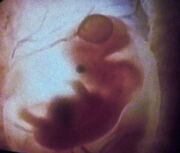m (I just made this page, forgot to logon while doing it, lol) |
m (typo fixed: a experience → an experience) |
||
| (10 intermediate revisions by 5 users not shown) | |||
| Line 1: | Line 1: | ||
| + | [[File:Ian Andrew Troi II embryo.jpg|thumb|[[Ian Troi]]'s [[embryo]] in [[Deanna Troi]]'s uterus.]] |
||
| − | The '''uterus''' is an organ of [[Reproductive system|reproduction]]. The name is derived from the latin word for womb. It is the main female reproductive organ of most [[mammalian|mammal]] species. Some non-mammalian species also possess a type of womb. Some species of [[fish]] or [[reptile|reptilians]], like certain types of [[shark|sharks]], will gestate their eggs internally in a structure that is similar to a womb. This structure will often lack a [[placenta]], though some maintain a more primitive placental link to their young. |
||
| + | The '''uterus''' or '''womb''' was an [[organ]] of [[Reproductive system|reproduction]]. It was the main female reproductive organ found in the [[anatomy]] of most [[mammalian|mammal]] species. It was the organ in which a child would grow after [[conception]] until [[childbirth]]. |
||
| ⚫ | A rare complication in [[Ktarian]]/[[Human]] [[pregnancy|pregnancies]] is, if the mother is human, when the baby shifts position in the uterus during the birthing process and the exo-[[cranial ridge]]s lodge in the uterine wall. If not resolved quickly, the uterus may rupture and result in internal bleeding and possibly even [[death]] of both mother and child. It is very painful for the mother and prevents the birth from taking place naturally. If this complication occurs, a [[fetal transport]] may be needed. ({{VOY|Deadlock}}) |
||
| − | It is the organ in which a child will grow after [[conception]] until [[childbirth]]. |
||
| + | [[Kira Nerys]] carried [[Keiko O'Brien|Keiko]] and [[Miles O'Brien]]'s second child, [[Kirayoshi]], to term in her womb due to a medical emergency following a [[shuttle]] accident. ({{DS9|Body Parts}}) |
||
| − | In humans one end opens up into the [[genitals|vagina]]; the other is connected to both sides of the [[fallopian tubes]] and [[ovaries]]. Human wombs grow a placenta during [[pregnancy]]. This organ is used to provide for the needs of the child via the mother until it can sustain itself on its own. |
||
| + | [[Harry Kim]] slept wearing an eye mask and claimed that it reminded him of being in his mother's womb, something he insisted to [[Tom Paris]] that he could remember. ({{VOY|The Cloud}}) |
||
| − | During pregnancy the uterus will stretch to several times it normal state in order to accommodate the growing embryo and later fetus. This distension can be noticed by medical scans. It will shrink back to its original size soon after birth. |
||
| + | [[B'Elanna Torres]] described her simulations in [[EV suit]] at [[Starfleet Academy]] as feeling "peaceful, like floating in the womb," but described an experience of a real [[space walk]] as making her a little [[space sickness|sick to her stomach]]. ({{VOY|Day of Honor}}) |
||
| ⚫ | A rare complication in Ktarian/Human pregnancies is, if the mother is human, when the baby shifts position in the uterus during the birthing process and the exo-cranial |
||
| − | |||
| − | When Charles Tucker once became pregnant a small pouch began to grow on the upper part of his chest. This structure was going to house the child until birth and is normal for a [[Xyrillian]] pregnancy. This might have been the Xyrillian equivalent of a human uterus. In this species the male carries the infant to term and is not genetically related to the infant. ({{ENT|Unexpected}}) |
||
| − | |||
| − | In Ocampan females between the ages of four and five, female Ocampa enter the elogium, the time of sexual maturation. During the elogium, a [[mitral sac]] forms on the back of the female. The sac accommodates a developing child, and it is from the sac that the child will be born as its mother stands upright. This is the Ocampan equivalent of a human uterus. ({{VOY|Elogium}}) |
||
| − | |||
| − | == See also == |
||
| − | *[[Anatomy]] |
||
| − | *[[Reproductive system]] |
||
| + | ==External link== |
||
| + | * {{wikipedia}} |
||
[[Category:Anatomy]] |
[[Category:Anatomy]] |
||
Revision as of 03:51, 17 May 2014

Ian Troi's embryo in Deanna Troi's uterus.
The uterus or womb was an organ of reproduction. It was the main female reproductive organ found in the anatomy of most mammal species. It was the organ in which a child would grow after conception until childbirth.
A rare complication in Ktarian/Human pregnancies is, if the mother is human, when the baby shifts position in the uterus during the birthing process and the exo-cranial ridges lodge in the uterine wall. If not resolved quickly, the uterus may rupture and result in internal bleeding and possibly even death of both mother and child. It is very painful for the mother and prevents the birth from taking place naturally. If this complication occurs, a fetal transport may be needed. (VOY: "Deadlock")
Kira Nerys carried Keiko and Miles O'Brien's second child, Kirayoshi, to term in her womb due to a medical emergency following a shuttle accident. (DS9: "Body Parts")
Harry Kim slept wearing an eye mask and claimed that it reminded him of being in his mother's womb, something he insisted to Tom Paris that he could remember. (VOY: "The Cloud")
B'Elanna Torres described her simulations in EV suit at Starfleet Academy as feeling "peaceful, like floating in the womb," but described an experience of a real space walk as making her a little sick to her stomach. (VOY: "Day of Honor")
